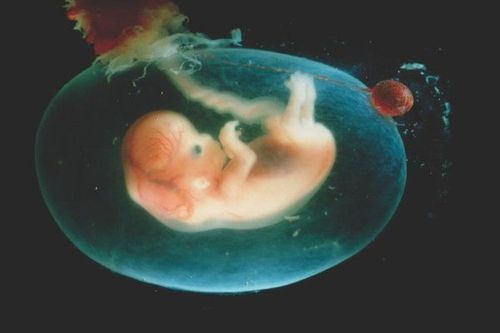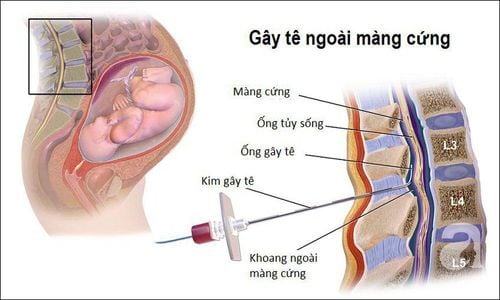This is an automatically translated article.
The article was professionally consulted by Specialist Doctor I Le Hong Lien - Department of Obstetrics and Gynecology - Vinmec Central Park International General Hospital. Doctor Lien has over 10 years of experience as a radiologist in the Department of Ultrasound at the leading hospital in the field of obstetrics and gynecology in the South - Tu Du Hospital.Amniotic fluid is a component that helps the fetus maintain normal development during pregnancy in the womb. However, amniotic fluid is not always normal, in many cases blue amniotic fluid, yellow amniotic fluid causes many dangerous complications for both mother and baby.
1. What is amniotic fluid? Amniotic fluid abnormalities
The fetus in the mother's uterus is surrounded by amniotic fluid. Amniotic fluid is a nutrient-rich liquid mucus with the ability to regenerate and exchange. Play an important role in the survival and development of the fetus during pregnancy.Amniotic fluid will appear from the 12th day after conception. Has the function of protecting and protecting the fetus from strong collisions and trauma. Especially helping to create a sterile environment for the baby.
Amniotic fluid at the beginning of pregnancy will be clear white, towards the end of pregnancy it will turn cloudy. When the fetus is full term (week 38) it will have a milky white color similar to the color of rice washing water. This is the normal color of amniotic fluid, which is safe for the fetus.
The abnormal case of amniotic fluid is when the amniotic fluid is blue and the amniotic fluid is yellow.
Phenomenon of yellow-green amniotic fluid: this is a sign of fetal hemolysis or underdevelopment of the fetus. Green amniotic fluid: This is an infection of the amniotic fluid, the baby has a high risk of infection in the uterus. The phenomenon of yellow or blue amniotic fluid is an abnormal condition of the fetus with many dangerous risks for the fetus such as fetal hemolysis, fetal distress, fetal malnutrition. If not detected early and have a timely plan can cause very high fetal death.

2. Phenomenon of hemolysis of the fetus
Fetal hemolytic anemia, also known as fetal hemolytic anemia, is a form of anemia in the mother caused by lower-than-normal red blood cells in the blood. When the mother has hemolytic anemia, there is a high chance that it will be passed on to the baby.Most pregnant women with hemolytic anemia have mild form (recessive gene). In these cases, the doctor will ask the husband of the pregnant woman to have a blood test to see if he is infected or not. If the husband has this disease, when giving birth to a child, the child will carry the dominant gene, which means that the child will be infected with severe hemolytic anemia. After birth, the baby's life will be associated with a blood transfusion.
If the husband does not have the disease, the probability is 50/50. That is, if you have the disease, it will also be mild, and the child will still have a normal life.
Therefore, mothers do not have to worry too much when being diagnosed with fetal hemolytic anemia. Because the rate of both husband and wife having hemolytic anemia is very low. These cases are mainly found in consanguineous married couples.
Trắc nghiệm: Mẹ bầu nên làm gì khi bị thiếu ối?
Nước ối đóng vai trò quan trọng trong sự tồn tại và phát triển của thai nhi. Trường hợp lượng ối quá ít (thiểu ối) thì sẽ tiềm ẩn những nguy cơ như gây thiểu sản phổi, chèn ép dây rốn,... Trả lời các câu hỏi trắc nghiệm sau sẽ giúp bạn có những cách phòng ngừa và điều trị kịp thời.The following content is prepared under supervision of Thạc sĩ, Bác sĩ y khoa, Tạ Quốc Bản , Sản phụ khoa , Khoa Sản phụ khoa - Bệnh viện Đa khoa Quốc tế Vinmec Phú Quốc
3. Pregnancy failure
Fetal failure is a condition in which the fetus is deprived of oxygen during pregnancy or labor. Fetal failure can cause brain complications, even death if not treated promptly. Fetal failure due to many causes, due to anemia, fetal infection, growth retardation, fetal malformation...One of the obvious signs of fetal distress is the abnormal color of the amniotic fluid.
Dark yellow amniotic fluid during pregnancy means that the fetus has chronic fetal failure, pregnant women need to be treated immediately. If the amniotic fluid is green, then there is a sign of fetal distress. In this case, the pregnant mother will be actively monitored by the doctor, depending on the status of the fetal heart, the process of labor, the doctor will have a timely treatment plan. Amniotic fluid contains the baby's meconium, in which case there is a high risk of acute fetal distress during labor. It should be handled quickly to avoid serious consequences. In addition, there are some signs of fetal distress such as irregular heartbeat, fetal movement disorder.
Phenomena such as abnormal amniotic fluid, fetal distress, fetal hemolysis often have no obvious clinical manifestations. Therefore, pregnant women need to choose a reputable medical address and regularly visit the hospital for examination and ultrasound to detect early signs of fetal abnormalities. From there, there is a timely treatment plan to ensure the safety of both mother and baby.
Vinmec International General Hospital always implements a package maternity care program for pregnant women with a full range of tests, comprehensive ultrasound during pregnancy, childbirth and after birth. Modern medical equipment and facilities, along with a team of experienced doctors, will help make pregnancy and childbirth safe and gentle.
Please dial HOTLINE for more information or register for an appointment HERE. Download MyVinmec app to make appointments faster and to manage your bookings easily.















